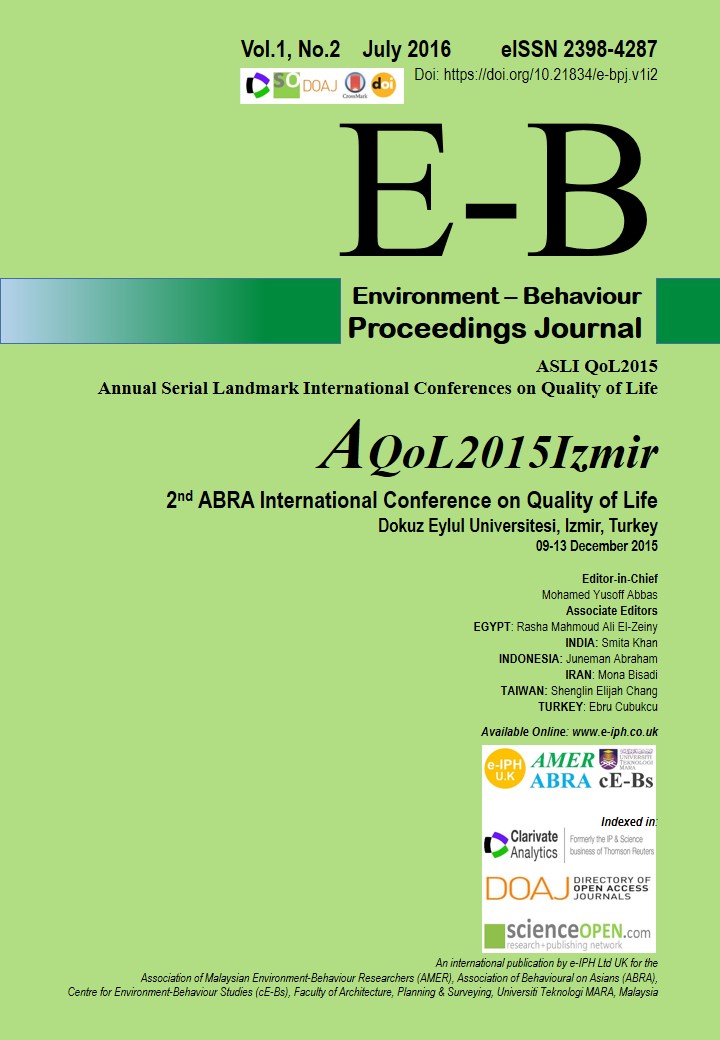Successful Attractions of Public Space through Users Perception
DOI:
https://doi.org/10.21834/e-bpj.v1i2.268Keywords:
Public Space, Successful Attraction, Users Perception, RevitalizationAbstract
The success of the revitalization program of urban public space is viewed through attractions that have been identified. This study aims to investigate the perception of users in public space through the on-site survey. In summary, the motivations, behavioural patterns, impressions on the public space as an attraction and the perceived importance of urban public spaces in the development of the city are important attraction for successful public space. The findings of this study will show main attraction in successful revitalization of urban public space based on users perception and can be used in a meaningful way to the users.
References
Bagwell, S., Evans, G., Witting, A., & Worpole, K. (2012). Public space management. London Metropolitan University.
Carmona, M., Heath, T., Oc, T. & Tiesdell, S. (2003). Public Places - Urban Spaces: The Dimensions of Urban Design. Oxford: Architectural Press.
Carr, S., Francis, M., Rivlin, L. g., & Stone, A. M. (1992). Public Space. Cambridge: Cambridge University Press.
Efroymson, D., Ha, T.T.K.T., & Ha, P.T. (2009). Public spaces: How they humanize cities. Retrieved from http://healthbridge.ca/images/uploads/library/Public_Spaces_How_they_Humanize_Cities.pdf
Federal Department of Town and Country Planning, Peninsular Malaysia (2005). Open Spaces in Urban Malaysia. Ministry of Housing and Local Government Malaysia, Malaysia.
Hong Kong Public Space Initiative (2012). The Ideal Public Space. Hong Kong: Hong Kong Public Space Initiative.
Jalaladdini, S. & Oktay, D. (2013). Interrogating Vitality of the Streets in Two Cypriot Towns. Asian Journal of Environment-Behaviour Studies, 4(11), 63-73.
Kurniawati, W. (2011). Public Space For Marginal People. Procedia - Social and Behavioral Sciences 36, 476-484. DOI: https://doi.org/10.1016/j.sbspro.2012.03.052
Kurniawati, W. (2012). Accommodative Study of Public Space for Marginalized People. Asian Journal of Environment-Behaviour Studies, 3(10), 1-10. DOI: https://doi.org/10.21834/aje-bs.v3i6.230
Namin, E. R., Najafpour, H., & Lamit, H. (2013). Public Places and Spaces and Social Urban Interaction (A Case Study of Johor Bahru, Malaysia). International Journal of Current Engineering and Technology, 3(2), 281-294.
Nasution, A. D., & Zahrah, W. (2012). Public open space's contribution to quality of life: Does privatisation matters?. Asian Journal of Environment-Behaviour Studies, 3(9), 59 - 74.
Okolo, N., & Okolie, A.O. (2010). Revitalizing urban public spaces in Nigeria through vegetative enclaves. Journal of Environmental Management and Safety. 1(1), 124 - 130.
Project for Public Spaces (2000). How to Turn a Place Around: A Handbook of Creating Successful Public Spaces. New York: Project for Public Space.
Rad, V.B., & Ngah, I. (2013). The Role of Public Spaces in Promoting Social Interactions. International Journal of Current Engineering and Technology, 3(1), 184-188.
Ramezani, S., Aziz, Z. A. A., & Idid, S. Z. A. (2009). Public space and conservation of a historic living city: Melaka, Malaysia. Retrieved May 20, 2014 from http://www.epublication.fab.utm.my/252/1/routledgevol42010.pdf.
Sangar, V. A. (2007). Human Behaviour in Public Spaces. Retrieved from https://www.be.unsw.edu.au/sites/default/files/upload/pdf/schools_and_engagement/resources/_notes/5A2_1.pdf.
Vogt, W. P., & Johnson, R.B. (1999). Dictionary of statistics and methodology. Sage: Thousand Oaks, California.
Downloads
Published
How to Cite
Issue
Section
License
Copyright (c) 2016 Maimunah Ramlee, Dasimah Omar, Rozyah Mohd Yunus, Zalina Samadi

This work is licensed under a Creative Commons Attribution-NonCommercial-NoDerivatives 4.0 International License.





